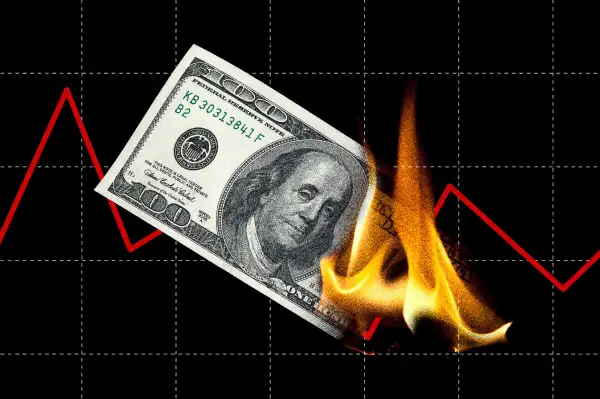What Investors Can Learn From the Worst-Performing Stocks of the Year
Money is not a client of any investment adviser featured on this page. The information provided on this page is for educational purposes only and is not intended as investment advice. Money does not offer advisory services.

The stock market is having a great year overall, but the same can’t be said for the shares of many individual companies.
The S&P 500, a benchmark index commonly used to measure the performance of the broad U.S. stock market, has hit record high after record high this year as companies posted record earnings and investors anticipated the current lower-interest-rate environment. As of Monday, the index is up more than 20% in 2024.
Still, familiar names like Walgreens, Dollar General and Lululemon are having a rough go of it. So understanding how to identify undervalued stocks as opposed to fundamentally flawed stock can be important for the overall health of your portfolio.
The S&P 500’s worst stocks in 2024
Howard Silverblatt, a senior index analyst at S&P Dow Jones Indices, provided Money with a list of stocks in the S&P 500 that have performed the worst so far in 2024. Those companies span numerous sectors, from health care to consumer staples to tech, and have done worse than merely underperforming the market.
In fact, many of them are significantly in the red since the start of the year:
- Walgreens Boots Alliance (parent company of Walgreens): -66.6%
- Intel Corp: -55.04%
- Dollar Tree: -50.09%
- Humana: -47.57%
- Lululemon: -47.12%
- DexCom: -45.11%
- Boeing: -40.54%
- Moderna: -39.47%
- Dollar General: -37.96%
- Lamb Weston Holdings: -36.3%
What do these struggling stocks mean for investors?
Seeing how far these stock prices have slid might make you fearful of investing in these companies. Alternatively, if you’re invested in mutual funds and exchange-traded funds (ETFs), you might be concerned about how much exposure your portfolio has to these losing stocks.
But don’t panic. It’s important to consider the time frame in which you’re measuring a stock’s performance. Companies can suffer from typical business cycles and market fluctuations, as well as challenges they can overcome with time, says Dave Sekera, chief U.S. market strategist for Morningstar. In fact, many of the current “losers” are examples of how you need to cut through the short-term noise to focus on the long term, he adds.
Take Lululemon for example. The company’s popular athleisure clothing was a favorite of people stuck at home during the pandemic lockdowns. It experienced sales growth during 2020 and 2021. And even as its customers eventually stopped buying yoga pants and sweatshirts, the market extrapolated, continuing gains based on Lululemon’s great performance.
That led to the stock being overvalued. However, now that Lululemon has come back to earth, it’s trading at an attractive price again, Sekera says. After bottoming at a four-year low in early August, shares of the company have gained 8.77% over the past month, outperforming the S&P 500’s gain of 3.65% over the same time.
Similarly, Dollar General and Dollar Tree reported a couple of quarters of disappointing earnings results as low-income consumers — the target demographic for both retailers — saw their wallets negatively impacted by high inflation over the last few years. As inflation subsides, those customers will likely resume their spending on discretionary items again, Sekera says, and the companies could see their sales pick up.
Yet not every losing stock can recover quickly or easily. Sometimes, changes in the underlying fundamentals of a company demand a lengthy and challenging period of rebuilding. Intel is a good example. While the semiconductor manufacturer was a leader in the space a decade ago, it’s fallen behind competitors amid managerial and other self-inflicted issues.
“Intel is going to need to spend a very significant amount on capital expenditures just to be able to catch up with its rivals, much less be able to regain the technological lead that it once had,” Sekera says.
The company’s free cash flow — a measure of financial well-being that shows remaining funds after paying for expenses and capital expenditures — has fallen from $11.26 billion in 2021 to -$14.28 billion in 2023, a decrease of nearly 227%. On a trailing 12-month basis, Intel currently shows -$12.58 in free cash flow, suggesting underlying fundamental flaws.
How to identify fundamentally flawed companies
Flagging companies that have fallen in price and likely can’t make a comeback is no easy task. An army of savvy Wall Street professionals make it their job to identify which companies will soar and which will plummet, but by no means is it an exact science.
Yet there are warning signs to watch for, beginning with a close read of a company’s balance sheet. It spells trouble if a company has negative cash flow — that is, less cash is coming into the coffers than is flowing out — for an extended period of time.
Similar worries may be triggered if a company long known for its dividend growth starts to cut those payments, or if earnings come in much lower than analysts’ expectations for consecutive quarters. Before sounding the alarm, though, compare these figures to those of its competitors, since the issue might be an industry-wide problem rather than one unique to the company in question.
Additionally, if a company is suddenly gaining popularity because of an emerging trend, that’s cause for concern. Industry trends-de-jour tend to run their course, and a company upsurge caused by one could be a sign that it’s not an investment worth sticking with for the long term.
The meme stock fad, for example, meant a surge in popularity for stocks of fundamentally-flawed companies like GameStop and AMC. But that trend proved to be risky, and highlights the danger of making investment decisions based on fear of missing out, or FOMO, rather than sound financials.
What investors should do now
While investments that are underperforming the market can sometimes present a strong opportunity for investors, they can also create an equally powerful risk. That’s among the reasons financial advisors often recommend investing in index funds rather than picking and choosing individual stocks.
Say you’re investing in an index fund that tracks the S&P 500. While your portfolio is influenced by the losing stocks we’ve outlined, those losses are weighted and often overshadowed by the gains of better-performing companies. As examples, consider electric utility company Vistra and chip designer Nvidia, which are up a whopping 334.57% and 175.94%, respectively, over the past year.
When you invest in individual stocks, you may be forcing yourself to make tough choices. On the one hand, you never know if a company experiencing these types of losses will remain in the red. On the other hand, panic-selling when a stock’s value dips could mean missing out on potentially high returns down the line when it recovers. Learning the basics of fundamental analysis can help you determine where to draw that line.
More from Money:
This Is the Most Boring (but Effective) Way to Become a Millionaire
This Stock Market Stat Has Predicted 83% of Presidential Elections in the Past Century
Grocery Stores Have Hiked Prices Beyond Inflation — and Their Stocks Are Soaring



